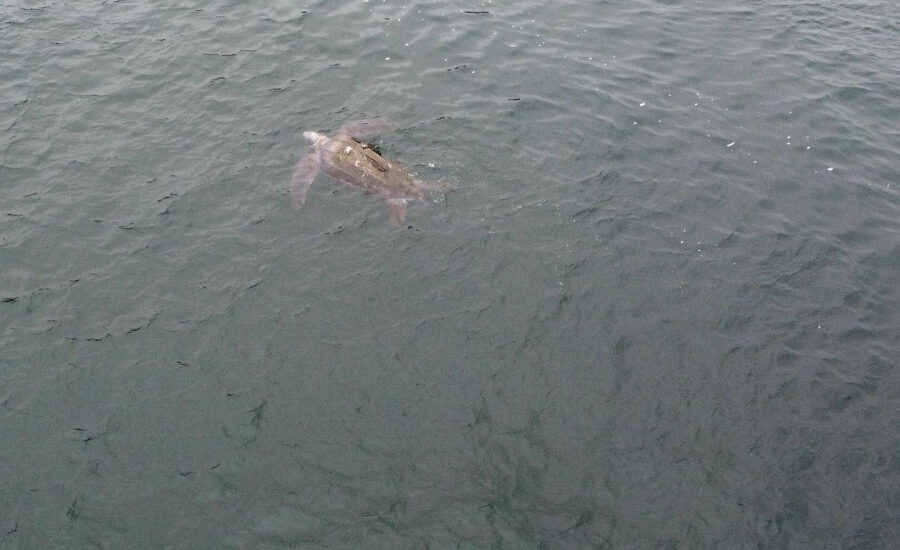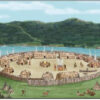
KJIPUKTUK (Halifax) – The weather at Owls Head provincial park rarely allows for kayakers to reach the park’s headland. Most days, its oceanic conditions fill the shoreline with damp fog, and the headland itself is often exposed to rough conditions. But July 6 was different: it was overcast, calm, and the waters were still.
“We got up to the bluff, and we were checking it out, and it was only probably within about five or ten minutes that we noticed something in the water,” Chris Miller, executive director of Canadian Parks and Wilderness Society Nova Scotia (CPAWS-NS), said.
“We went to the edge of the cliff [at the headland] to get a better look, and that’s where we noticed the sea turtle. And it’s very obvious – as soon as you see a leatherback sea turtle you know what it is.”
On the day of the sighting, Miller was collecting and documenting scientific data on Owls Head Park as part of a CPAWS-NS research effort. CPAWS-NS is a grassroots organization that works to establish protected areas across the province. It’s part of a national organization with chapters in each Canadian province.
“This is a species in trouble,” he said about the leatherback turtle. “There’s been a 70 per cent decline in this population globally, and the population is continuing to head in the wrong direction.”
Designated as an endangered species in 2003, the leatherback sea turtle migrates across the Atlantic or Pacific oceans after nesting. They’re the world’s largest reptile – weighing up to 2,000 lbs – and feed on jellyfish. The Atlantic leatherback sea turtles that have been seen off the coast of Nova Scotia are facing a 5 percent population loss annually.
‘The more you look, the more you find’
In 2019, Owls Head was delisted as a provincial park by the government and has since been in the process of being sold to a private developer. Since the CBC exposed the secretive process later that year, CPAWS-NS has been “boots on the ground” at Owls Head Park collecting data. Miller says that important ecological reasons to protect the park have only continued to grow.
“The more you look, the more you find,” he said, explaining that they’ve identified up to 91 species of coastal seabirds on site as an example of the location’s importance. Sightings like the Atlantic leatherback sea turtle are helpful in ensuring the conservation of the park; however, Miller says it depends on the government’s response.
“The problem is that the government has already delisted the site and has already entered into that agreement with the developer for the next steps,” he said. “And so, we’re pretty far down that road, and that’s very concerning because we have to stop the land sale to get this property back into the protected category and make sure it receives legal protection.”
“The earth is under a lot of pressure,” he said. “Right now, our natural ecosystems are our support systems on the planet. Between the climate emergency and the biodiversity crisis, we’re in big trouble.”
Sightings from shore ‘incredibly unusual’
Katherine Martin, a founding member and the executive director of the Canadian Sea Turtle Network, says that the sighting isn’t abnormal this time of year. In fact, the Network received two calls on July 6 with sightings of the leatherback turtle at Owls Head Park.
“We expect that the turtles are going to be here at this time of year,” Martin said, explaining that their proximity to the shore was what was rare. “The chance of a person seeing one of those turtles from the shore the way they did, that’s incredibly unusual – I wouldn’t say that’s happened more than half a dozen times in over 20-years.”
The Atlantic leatherbacks make their way along the coast of Nova Scotia in the summer and stay to feed into the fall. While each year differs in how many sightings are reported to the Network, most happen to be in a boat on the water.
Martin explained that because the species is endangered, there’s a lot that’s left unknown about the turtle. Outside of understanding the leatherback’s hatching and feeding locations and processes, little is known.
“It’s one of those things where you get this moment to think about the world as so much bigger than who you are,” she said about sightings. “Like a sense of time that exceeds human time, and a sense of the world that exists, even despite everything that humans do.”
She said she was especially happy to hear about the CPAWS-NS sighting, because “when you’re working so hard to try and do something like protect Owls Head, just a moment for nature to look back at you and say ‘yeah’ – I think that’s really important.”
If you’ve seen an Atlantic leatherback turtle and would like to report it to the Canadian Sea Turtle Network, you can call their toll-free number at 1 (888) 729-4667.
See also: Nova Scotia’s secret treasure: Vital eelgrass ecosystem threatened by proposed Owls Head golf course
Check out our new community calendar!
With a special thanks to our generous donors who make publication of the Nova Scotia Advocate possible.
Subscribe to the Nova Scotia Advocate weekly digest and never miss an article again. It’s free!




OWLS HEAD is an election issue for sure Consider that when you vote please.M